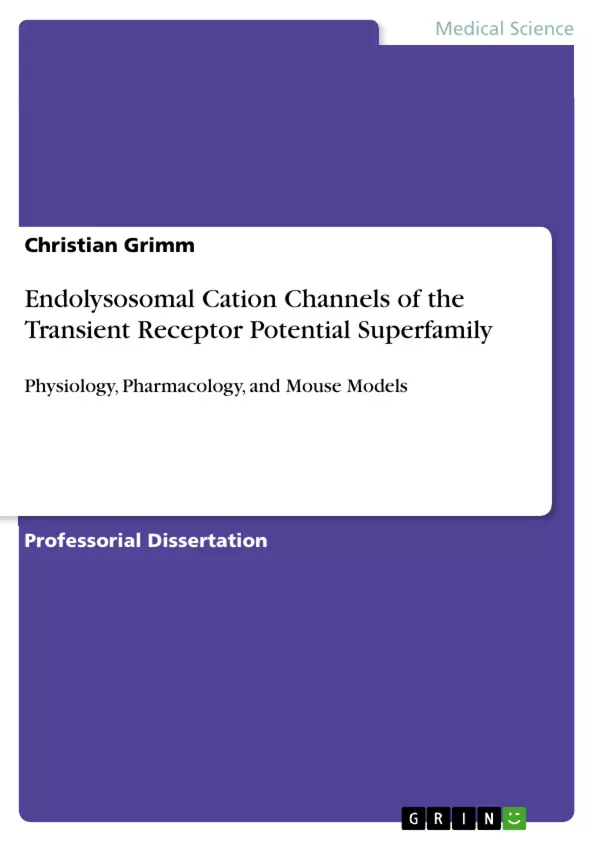Lysosomes are cell organelles involved in the breakdown of proteins, lipids, and other molecules and have been implicated not only in endolysosomal storage disorders (LSDs) such as mucolipidoses or mucopolysaccharidoses but also in metabolic diseases, neurodegenerative disorders such as Alzheimer’s and Parkinson’s disease, pigmentation disorders, or infectious diseases. Highly critical for the proper function of lysosomes, endosomes, and lysosome-related organelles is the tight regulation of various fusion and fission processes and the regulation of proton and other ionic concentrations within the endolysosomal system. Calcium permeable, non-selective cation channels of the TRP (transient receptor potential) superfamily, namely TRPML channels (mucolipins) and TPCs (two-pore channels) have been found to play important roles in these processes. This thesis provides insights into the function and physiology of TRPML and TPC channels, explains the molecular basis of pathologies associated with diseases caused by loss or mutation of these channels, and discusses potential therapeutic approaches.
Inhaltsverzeichnis (Table of Contents)
- List of original publications selected for this „Habilitationsschrift”
- Introduction
- Analysis of the TRPML3 varitint-waddler mouse mutants
- Development of small molecule agonists for TRPML channels
- Functional investigation of MLIV causing TRPML1 mutants
- Novel TRPML channel interaction partners
- Functional analysis of the TPC2-/- knockout mouse
- Novel TPC channel interaction partners
- Summary
- References
- Curriculum vitae
- Complete list of original publications
- Personal contributions to the selected original publications
- Acknowledgement
Zielsetzung und Themenschwerpunkte (Objectives and Key Themes)
This habilitation thesis explores the physiology, pharmacology, and molecular mechanisms of endolysosomal cation channels belonging to the transient receptor potential superfamily (TRP). The research focuses primarily on TRPML and TPC channels, investigating their roles in various cellular processes, including sensory perception, lysosomal function, and metabolic regulation. The main objectives are to uncover the physiological roles of these channels, identify novel drug targets, and develop therapeutic strategies for related diseases. Key themes explored in the thesis include:- The role of TRPML3 in deafness
- The development of small molecule agonists for TRPML channels
- The function of TRPML1 in mucolipidosis type IV
- The identification of novel TRPML and TPC channel interaction partners
- The impact of TPC2 deficiency on fatty liver disease
Zusammenfassung der Kapitel (Chapter Summaries)
- List of original publications selected for this „Habilitationsschrift”: This chapter provides a list of the original publications that form the basis of this habilitation thesis.
- Introduction: This chapter introduces the transient receptor potential (TRP) superfamily of ion channels, highlighting their diverse functions in various cellular processes. It specifically focuses on TRPML and TPC channels, emphasizing their roles in lysosomal function, sensory perception, and metabolic regulation.
- Analysis of the TRPML3 varitint-waddler mouse mutants: This chapter delves into the investigation of TRPML3 function, focusing on the varitint-waddler mouse model that displays a specific mutation in the TRPML3 gene. The study aims to elucidate the role of TRPML3 in hearing and the impact of this mutation on sensory hair cell function.
- Development of small molecule agonists for TRPML channels: This chapter describes the development of small molecule agonists for TRPML channels, particularly TRPML3. The research focuses on the identification of compounds that can activate these channels, potentially leading to therapeutic strategies for related diseases.
- Functional investigation of MLIV causing TRPML1 mutants: This chapter explores the functional consequences of specific mutations in TRPML1, which are associated with mucolipidosis type IV (MLIV), a rare lysosomal storage disorder. The study aims to understand how these mutations affect TRPML1 channel activity and its role in lysosomal function.
- Novel TRPML channel interaction partners: This chapter investigates the protein-protein interactions of TRPML channels, exploring the identification of novel interaction partners that may influence their function and regulation.
- Functional analysis of the TPC2-/- knockout mouse: This chapter focuses on the functional analysis of TPC2 knockout mice, investigating the role of TPC2 channels in lipid metabolism and the development of fatty liver disease.
- Novel TPC channel interaction partners: This chapter examines the protein-protein interactions of TPC channels, identifying novel interaction partners that may contribute to their regulation and function.
Schlüsselwörter (Keywords)
The habilitation thesis centers around endolysosomal cation channels, particularly TRPML and TPC channels. Key keywords include: TRP channels, TRPML1, TRPML3, TPC2, lysosomes, sensory perception, deafness, mucolipidosis type IV, fatty liver disease, small molecule agonists, protein-protein interactions, mouse models, and pharmacology.- Arbeit zitieren
- Dr. rer. nat. Dr. phil. Christian Grimm (Autor:in), 2014, Endolysosomal Cation Channels of the Transient Receptor Potential Superfamily, München, GRIN Verlag, https://www.grin.com/document/284634



